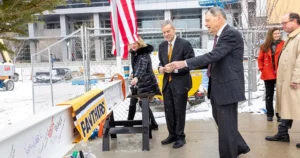A journey that began a year ago on a frozen January day reached a significant milestone on another frozen January day.
Faculty, staff, students and construction workers gathered on Thursday, Jan. 26, at the Lubar Entrepreneurship Center to enjoy hot drinks and watch as the highest beam was lifted into place atop the university’s new chemistry building. The topping off ceremony marks a significant milestone for the building, which is scheduled to be completed in late 2023 or early 2024.
In building construction, a topping-off ceremony is typically held when the highest beam or its equivalent is placed on a structure. The tradition originated in ancient Scandinavia, and in keeping with that tradition a small fir tree was attached to the UWM beam. Participants also got the chance to sign the beam before it was raised into place.
‘Truly foundational’
The new four-story, 163,400-square-foot building will support vital teaching and research in chemistry, Chancellor Mark Mone said at the ceremony. UWM has more than 5,000 students taking chemistry courses annually. It’s not just scientists in white coats and goggles who study chemistry, he added. Fields such as forensics, nursing, medical technology, environmental science and teaching all rely on chemistry courses as part of student preparation. “This is truly foundational to so many fields at UWM,” Mone said.
The new facilities will support learning for UWM chemistry students and students in fields ranging from freshwater sciences to engineering, said Kristen Murphy, professor and chair of chemistry and biochemistry.
“Teaching is a focus of what we do” and the new building will give the disciplines an environment that will better support that, Murphy said. But the facilities will also help prepare K-12 teachers and their students. The building’s new outreach lab, for example, will provide an integrated space that can be used for multiple purposes to support learning for teachers and students studying to be teachers.
Important for industry
The chemicals industry is the fifth-largest manufacturing sector in Wisconsin, Mone said, and UWM graduates are vital to that industry.
Jim Harvey, senior vice president and chief science officer for NorthStar Medical Radioisotopes, talked about the importance of the talent pipeline to that growing company. NorthStar, which is located in Beloit, has hired doctoral and other UWM graduates who work to support the company’s nuclear medicine business, producing radio pharmaceuticals. These are used in the diagnosis and treatment of many diseases, including cancer and heart conditions. These products and technologies will continue to be vital to health systems and patients into the future, he added.
The three doctoral students he hired from Professor Mark Dietz’s lab, for example, have helped the company grow, he said.
“What we have found is that we can give these young people that we have hired major projects important to our company and they can hit the ground running,” Harvey said. “This is the type of student we need; this is the type of graduate we need.”
‘Very remarkable’
UW System Regent Scott Beightol said he has had a unique opportunity to see the work UWM is doing. His wife attended UWM, and his daughter is a current student. So, he has a firsthand look at the work staff and faculty are doing, he said.
“This school is very remarkable,” Beightol said. Many students come from working class backgrounds or are working while in school. They combine a strong work ethic and drive with a high-quality education. And UWM graduates tend to stay in Wisconsin, helping fill the state’s talent pipeline and become productive citizens, he added.
By Kathy Quirk, University Relations
